
Alan Wake
Written by: Rik
Date posted: October 31, 2020
- Genre: Action
- Developed by: Remedy Entertainment/Nitro Games
- Published by: Remedy Entertainment
- Year released: 2012
- Our score: 6
“I’m Alan Wake,” says Alan Wake, the lead character in the game Alan Wake. “I’m a writer.” Alan may indeed be a writer, but as we join him on the way to the small town of Bright Falls, he’s finding it hard going, and is in need of a rest and some inspiration. Unfortunately, as it turns out, Bright Falls turns out to be a damned creepy place, not the right setting for a relaxing holiday at all, and definitely not the place to rediscover your zest for writing. Alan doesn’t even know that he’s there to do that, though, until he realises that it’s a plot, of sorts, cooked up by his wife and agent to get him out of his creative funk. After throwing a bit of a strop upon discovering their subterfuge, things go from bad to worse for Alan as his wife Alice disappears and he finds himself in a crashed car having lost a whole week of his life, accused of Alice’s murder, and pursued by sinister hordes of possessed locals intent on causing him harm.
Broadly, the game does its storytelling and scene setting during daylight hours, as Alan wanders around Bright Falls, interacting with non-possessed (but oddball) townsfolk while trying (and failing) to keep a low profile, despite his moderate celebrity. It’s not an adventure element as such, more a case of going where directed and listening to conversations unfold. Come nightfall, it’s baddies and combat galore as you find that a dark energy takes over the town, causing you to come under attack. Survival depends on hitting these advancing forces with blasts of light, usually from your trusty torch, to eliminate the darkness within before finishing them off with a firearm. (These poor souls are unable to be saved, it seems!)
Alan Wake is what Finnish developers Remedy did next after Max Payne 2: The Fall of Max Payne. Early indications were that it would be an ambitious, open world affair, and that PC gamers would need to be running [much-hyped OS of the mid-00s] Windows Vista in order to play. Any rumblings of disappointment from the PC gaming community soon deepened when Wake later became an Xbox 360 exclusive, thanks to a publishing deal with Microsoft. However, the game that belatedly emerged in 2010 (and, finally, to PC two years later) was not, in fact, an open-world caper, and subsequent tales were told of a difficult development during which such ambitions proved hard to reconcile with a coherent narrative. In other words, Alan Wake ended up being a fairly linear action-adventure. For me, it also meant that a game that I was expecting to be nothing like Max Payne turned out to be rather like Max Payne.
I was not anticipating thinking about the two Payne games very much while playing, except perhaps noting a nod and a wink here and there, or mentioning them much in this write-up, other than to say that I was a big fan and that anything else produced by Remedy was likely to be of interest. But Alan Wake feels so similar to Max Payne that I couldn’t help but make comparisons. And those comparisons don’t do Alan too many favours.
For example, those expecting a balance of action and adventure may be surprised by how much action there is. Rather like Max, Alan is a “hammer a few baddies, get rewarded with some more story” type of game, and as you progress, those calmer, story-based interludes become briefer as the action intensifies. Background is provided via the radio and TV sets found throughout Bright Falls (again, in a similar fashion to Max Payne), but there are also cut-scenes, which are a bit ropey and don’t fare well alongside either the very nice in-game visuals, or indeed the graphic novel interludes of Alan Wake‘s precursors.
When it comes to the action, Alan is meant to be less of a badass than Max, but the two do seem to share a few traits, including a habit of opening doors by running into them and an extremely stiff jumping technique. Unfortunately, Alan doesn’t have the ability to slow down time, handle a wide range of weaponry, or dodge enemies with any sense of panache or precision. Instead, he can run away (for a bit, before becoming short of breath), attempt to duck out of the way of close-range attacks, or fend off the hordes through the light and gun combination mentioned earlier. As a main gameplay mechanic, the general feeling it creates is of mild panic and clumsiness as you try to keep moving, get your torch trained on advancing enemies and fire off bullets; while at the same time also managing your torch battery levels and keeping your gun loaded. Perhaps this is deliberate, and something that fans of survival horror games are used to, but it does mean that moments of satisfaction are experienced only intermittently.
If there are elegant ways to engage with and dispatch enemies, through efficient use of resources, they are largely rendered unnecessary by the plentiful supplies of batteries and ammunition scattered around the game world. In particular, battery life is depleted very rapidly when you boost the torch with the right mouse button, which fizzes away the darkness from opponents more quickly. For the moments when Alan is particularly outnumbered, there are supplies of flares and flashbangs, while at other times the environment can be used, either through independent sources of light, or, that old gaming chestnut, the exploding cylinder. Equally familiar as an action game trope is the discovery of new weapons and supplies shortly before encountering a situation in which they might be urgently needed, but here it seems particularly obvious, with big stacks of ammo, flares and batteries likely to elicit an involuntary sigh from anyone not particularly enjoying the action.
Part of the problem is that if you do find it unsatisfactory, there’s not a lot of variety ahead, although some enemies possess distinguishing behaviours, and beefier bodies generally take more light and bullets to put down. None of them have guns, but you do have to watch out for projectiles being thrown, as well as the sound of a chainsaw in some cases. Dive-bombing ravens are also an occasional threat, and as you progress through the game, the darkness increasingly takes hold of inanimate objects and scenery and starts flinging them your way. Dodging is an option, but you ultimately have to get rid of them with light from your torch otherwise the attacks won’t stop. While the light and gun combo can produce some memorable moments, shining your little torch at a piece of farm machinery to destroy it doesn’t quite feel the same.In any case, your arsenal is rather limited and revealed rather early: you have access to a revolver, two types of shotgun, a hunting rifle and a flare gun. Your torches can be upgraded too, but I didn’t find the effect all that noticeable. Alan tends to lose all of his items at various points anyway, and this makes the subsequent re-arming process, as described above, even more obvious. Management of health is also out of your hands: it regenerates automatically as you avoid getting hit, and in its entirety when you reach a light-based checkpoint (yes, this is a checkpoint save affair). There are occasional driving sections, which mix things up slightly, in which you can use your car headlights to weaken opponents and then run them over. Likely a relic from the open-world blueprints, these are perfectly okay, but deployed reasonably sparingly.
Which leaves us with the tale itself, which I again found rather uneven. Alan is a bit of a classic unsympathetic wally, dealing with writer’s block, a fondness for booze, and a big ego. The setting is inspired by Twin Peaks (with which I’m not familiar) and the story by the work of Stephen King (with which I am more so). With regard to the latter, certainly, it feels less at times like a knowing homage and more that his stuff just keeps turning up in the game. We start off with Alan quoting King directly, and it’s not long before there’s not only an axe-through-the-door scene straight from The Shining, but a comment from our hero telling the player ‘this is like Jack Nicholson in The Shining’, in case you didn’t know. For me it seemed like there was rather too much direct referencing going on: I remember some people being really annoyed at Max Payne‘s story packing in the references to John Woo et al, although as someone largely ignorant of that particular area of popular culture, perhaps that’s why it bothered me less there.
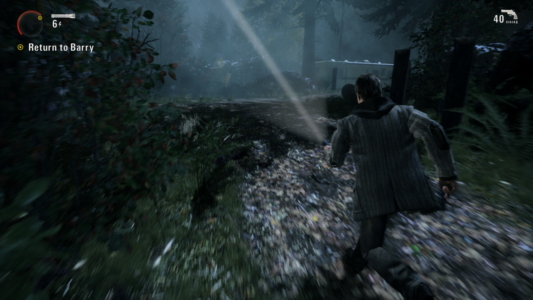
I don’t quite understand the quirky camera placement in this game, but perhaps it’s the modern style.
I’m by no means a Stephen King superfan or expert (I haven’t read, or seen, The Shining, for example, and I’m not familiar with Bag of Bones, with which Alan Wake‘s setup seems most closely aligned) but to me the main hallmark and strength of his writing is not necessarily the supernatural scares, but the human element, and I think that’s missing here: even if you’re not meant to like Alan, I’m not sure his characterisation is quite as layered as it might be, and redemption is pretty slow in coming, to the extent that I really didn’t warm to him until the two additional DLC chapters (The Signal and The Writer, which come bundled with the PC version as standard). I also didn’t find it especially easy to follow what was happening, even with the split into an episodic format, with a recap before each one like a TV show (which still, bizarrely, doesn’t allow you to end at the conclusion of each one and instead forces you to start another before you can save).
In planning to write up my thoughts here, I promised myself that I’d try not to moan too much at the outset, in case it risked overstating my disappointment, and this is a goal that I have missed rather spectacularly. However, let me belatedly try to redress the balance, as there is lots to admire here. For a start, as already noted, it’s a very nice-looking game, with atmosphere in abundance, and the swirling, blurry fog that represents nearby darkness particularly effective. Speaking as a gaming coward, I found the tension effective without ever becoming overwhelming, and I didn’t even mind the occasional jump scare.
There are plenty of interesting and visually impressive set pieces, some of which require clever use of the environment and/or management of torch and weapons, to hold off advancing hordes for a set period of time, and these work well. I tended to prefer the action sections that were set in the town, a more interesting setting, in my view, for a haunted shoot-out than the sometimes endless-seeming sections in the woods. A couple of moments (one, late on in the main game, in which you pair up with the local sheriff to blast your way through the town centre; and another right at the beginning of the first DLC episode where several baddies come at you inside a diner and you have to make a plan to hold them off and blast them with limited available time, space and resources) stood out as particularly enjoyable and gave me pause to consider whether the action should have embraced the survival horror/urban shoot-out aesthetic a little more and become a bit tighter and leaner as a result. But there are still some good moments, as it is.
Speaking of the DLC episodes, I’m not sure to what extent people consider them part of the main game, but seeing as all versions of the PC release include them, and they continue the story, I’m going to do so. As I mentioned, Alan as a character seems to open up a bit more in these episodes and appeared more rounded and shaped by events than he does at any stage in the main game. I also enjoyed the extra urgency these episodes seemed to possess, and the heightened sense of weirdness that permeates through both of them (although to say too much more would be quite spoilery).
They’re generally a positive addition, but each contains one fairly awful action sequence: in the first, there’s one in which it’s not entirely clear that the only way to get through it is to run away, and in the second there’s an interminable battle that involves shining a torch at a number of evil televisions. And both episodes are ultimately non-committal in terms of changing the original ending, which is probably a feature of their origins as bonus extras.
Overall, I did still broadly enjoy Alan Wake, and perhaps my expectations were unfair. It’s certainly an ambitious if uneven experience, in terms of action and story, with both elements guilty of sagging and bloating at times, but certainly by the end of the second DLC episode I felt somewhat satisfied that a good yarn had been spun. At its best, it did indeed remind me of Max Payne; at its worst, it’s more like one of his dream sequences. I’d give it a moderate recommendation, and there’s a good chance you may like it even more than that.

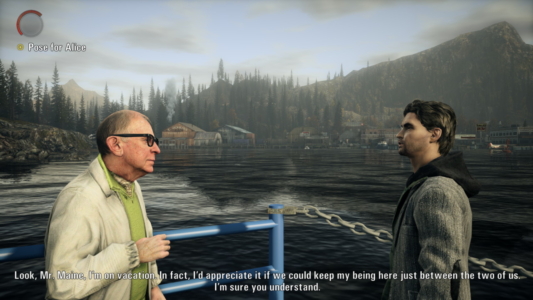
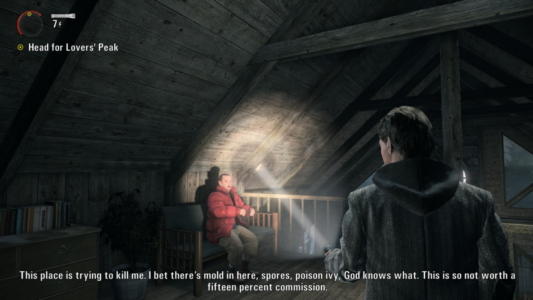
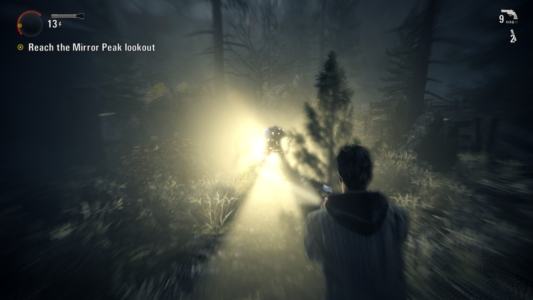
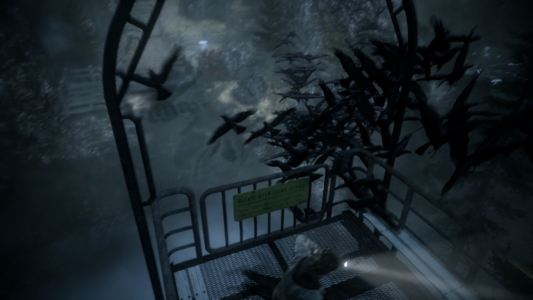
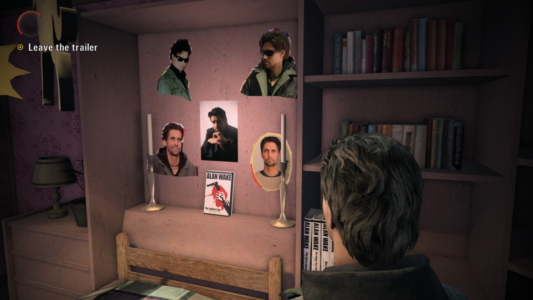

 Posts
Posts
Did the “moments frozen in time” bits only show up in the DLC? That was a highlight for me, and Remedy too apparently, as they made a whole game out of it with Quantum Break.
Agree that it was much more shooty than expected or appreciated. I think I was supposed to be elated after holding off possessed during the “rock concert,” but was mostly exhausted. Some good story, some memorable moments, a lot more semi clunky action than there needed to be. So, a post Max Payne Remedy joint.
Played on the 360, so I imagine the graphics are improved on PC. Any issues without a controller? I also remember something about branded batteries or a cell phone riling up gamers at the time?
And the “it’s not a river… IT’S AN OCEAN!” in the last (?) DLC that explained nothing and just left the entire story hanging. Good times.
October 31, 2020 @ 10:37 pm
The bits where you shine the torch on words in the game world are in the DLC, yes. Kind of cool when you’re setting those blasts off in the basement, but kind of annoying when your supplies fall off the edge of a cliff after dropping.
I agree about those big set pieces like the rock concert: perhaps you’re supposed to just feel exhausted and relieved, but it’s less satisfying than, say, having cleared a room in Max Payne, and often I felt like I’d fumbled through these bits more than anything else.
I must admit to having a bit of a blind spot when it comes to what the 360 (or any subsequent consoles) can do vs PC and just sort of assume that the visuals will just be a bit sharper on the latter. (I do have a 360 and have even used it recently but there tends to be little crossover in terms of games I have/could play on PC).
Apparently the graphics have been spruced up quite a bit in terms of resolution and draw distance: I suppose this is unusual in not being a straight multiformat release and they had some extra time to mess around with it. The 360 controller is an option, and I imagine that if you’re the kind of person who can use these competently for action games (i.e. most people) then the control scheme might seem a bit more logical than with KB and mouse, but the latter worked perfectly fine for me.
The batteries in the main game are Energizer branded and it is a bit gratuitous but not something that bothered me massively (they become generic batteries in the DLC). Given how often you have to change them in the game, it’s not a great advert for their product. There’s a lot of mention of Verizon too although that company doesn’t operate in the UK (I don’t think) so it seemed largely meaningless. (Alan does say ‘Can you hear me now?’ at one point, which is apparently a well-known slogan of theirs, but it went over my head).
That last line is in the main game. The DLC suggests more of a resolution but ultimately cops out of it. Which I guess you can understand, I imagine putting the actual ending in an add-on instead of the main game would have lots of people up in arms.
November 1, 2020 @ 9:19 am